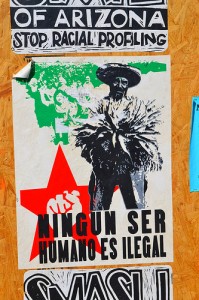
67 Sueños mural, by Pancho Pescador in collaboration with the Community Rejuvenation Project, San Francisco
In honor of the recent International Workers Day (May Day) celebrations, I write today about immigrant justice. While May Day’s long history is centered around workers rights more broadly, our workforce has always been made up of a large number of recent immigrants — particularly in the most exploitative jobs. And it was the immigrant rights movement that revitalized the holiday in the US in 2006 with its strike, “A Day Without Immigrants.”
The struggle for immigrant justice is of course a political one. But it is also cultural. It is about changing the way we think about immigrants, and the stories we tell. Despite being a nation founded on immigration from Europe and the genocide of native peoples, the dominant narrative today is of dangerous, unlawful, and above all “illegal” immigrants coming to take what is rightfully “ours.” We have moved from talking about “illegal immigration” to talking about “illegal immigrants” — a small but important shift in subject. In the process, the word “illegal” has become more than a judicial term; it has become a racial epithet, and shorthand for this dominant — and false — story.
But a counter-story has emerged, finding its most condensed form in the powerful slogan “No Human Being Is Illegal.” While I’m not sure where the phrase originally emerged, it seems to have been popularized by a particular piece of art. The poster, seen to the right, was used in 1988 as part of a campaign by the Central American Resource Center in LA, fighting for the rights of Central American war refugees. It features a stirring image by artist Mark Vallen. In 2010 the poster was republished, to support the current fight for immigrant rights.
The phrase has spread like wildfire, serving as a call for humanization across the world. It has spawned murals, t-shirts, posters, graffitti, and more.
The most recent iteration of this struggle is the Drop the I-Word campaign. An effort that started with paint and posters is now taking advantage of social media and digital video. Launched by the Applied Research Center and its (excellent) website Colorlines, the Drop the I-Word campaign calls on media outlets, as well as other organizations and individuals, to pledge to stop using the term “illegal” to refer to people. As they state on their site:
Use of the i-word ignores the fact that our laws are unjustly applied. Immigrants without documents are regularly hired as cheap, exploited labor. No one else who benefits from the set up, including the employers who recruit and hire these migrants, is labeled this way. No one should ever be labeled this way. No human being is illegal.
So in honor of May Day, or just because it is a Thursday and it feels right, pledge to drop the i-word. Absolutely no human being is illegal.







One thought on “Drop the I-Word: From Paint to Pixels”
Comments are closed.